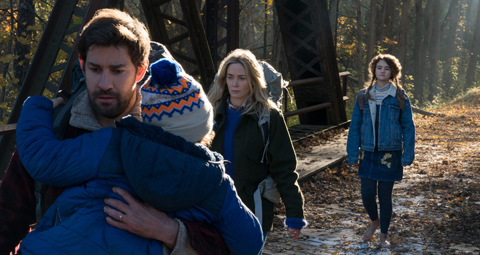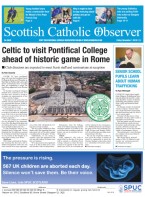BY James Farrell | December 27 | ![]() 0 COMMENTS
0 COMMENTS ![]() print
print

A quiet catholic message, hidden in horror
Hit monster movie A Quiet Place, James Farrell argues, is the film of 2018 with its subtle themes that speak to a Christian ethos.
Do you have any film recommendations? It’s a question we often ask during the Christmas holidays.
The free time in the evening, cold damp weather outside, leftover Christmas dinner, a surplus of Christmas drink and the odd cracker and cheese all amount to an inevitable night cemented to the couch in search of something to watch.
In answer to that question, I’d recommend A Quiet Place, the film Bishop Robert Barron, the American evangeliser, described as the ‘most unexpectedly religious film of the year.’
It was on that simple description I ventured to see the thriller earlier this year and I wasn’t disappointed.
The plot is simple; the story takes place on a large farm where a young family quietly set about living a monastic lifestyle.
The Abbot family are living in a world in which the slightest noise attracts a terrifying monster, which neither they nor we know much about.
Horror
The dangers of this world are illustrated in the opening scenes. The couple’s youngest son shatters the cautious silence when a toy rocket he is playing with begins to shriek. Horror etches onto the faces of the parents as they realise what is about to happen. The mother covers her mouth, unable to release the scream she holds, while the father rushes to the son. Too late. A monster devours the boy almost instantaneously.
We now know that this family is surrounded by a culture of death. Things that are all too common for us—speech, laughter, tears, movement—would lead to death.
To survive in this world requires a counter-cultural lifestyle, one of silence, walking bare-foot, returning to a simplistic production of food. The Abbot family return to this way of life rather than give in to despair.
The film conveys a rare positive depiction of family life. Despite all the difficulties you can imagine, the family give of themselves to each other. They work together to keep themselves alive, in the field and in the house, with both parents taking teaching roles for their children.
‘School of Christian life’
The family is an accurate image of the ‘domestic Church’ described in the Catechism: “The home is the first school of Christian life and ‘a school for human enrichment.’ Here one learns endurance and the joy of work, fraternal love, generous—even repeated—forgiveness, and above all divine worship in prayer and the offering of one’s life” (CCC 1657).
Despite the idyllic image of the family, suspense comes from their need to live in silence. The daughter is deaf, and there is a danger that lurks with her every movement, unaware as she is of the noise she makes. Her father works tirelessly to protect her, trying to make her a working hearing aid from scrap parts that he finds. She has little hope. “It never works,” she tells him in sign language.
Pro-life parallels
The film intensifies as we realise the mother is expecting another child. It provokes an almost subconscious reaction in the audience, prompted by our culture’s current attitude towards life. For many would ask, how could you get pregnant in such a dangerous environment? How could you bring a child into this world when it will almost certainly kill you, your husband and your two children?
The family don’t despair however; instead they work to prepare for the child coming. The filmmakers even have the audacity to show the mother with a stethoscope listening for the heartbeat of the child, one of the few ‘loud’ moments in the film.
Other religious themes
The religious motifs continue, with the family joining hands at the dinner table in one scene and silently praying grace—being thankful for what they have in the darkest of situations. These quiet moments begin to ramp up towards the climax of the film.
The film begins to explore explicitly the vocation of family life, and in particular of parenthood. The mother asks her husband: “Who are we? Who are we if we can’t protect [our children]?”
It highlights how they view their vocation, that they find in their parenthood ‘who’ they are, and within that, the role they must take.
As the mother enters labour, noise enters the film, and so do the monsters seeking to devour mother and child. To counter those noises the children create distractions. With the two children stuck in a jeep, and with the monster trying to gouge them, they look out the rear window to their father.
He looks at his children and, in sign language, tells them: “I Love you. I have always loved you.” And in a Christ-like manner, he sacrifices himself so that his children will live. He screams, drawing all evil to himself. The children escape.
The father, like Christ, has given them a gift, which will continue to give them life. At the film’s conclusion, a hearing aid the father made for his daughter before his final sacrifice sends out a frequency, which disorients and disables the monsters, leaving them defenceless and allowing the family to live. It is this act of self-sacrificial love from the father which makes this film the ‘most unexpectedly religious film’ of 2018.










